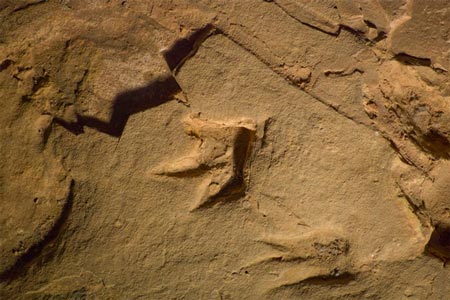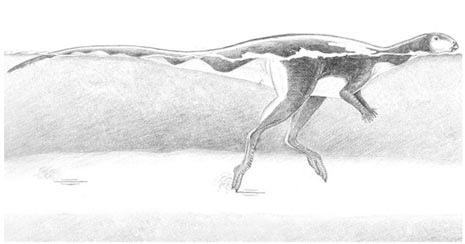New Study into the Lark Quarry Dinosaur Footprints
The Lark Quarry located near the town of Winton in Queensland (Australia) is the site of one of the most important collection of dinosaur tracks discovered to date. When these tracks were first studied by Dr Tony Thulborn and his colleague Mary Wade and their work published in 1984, the footprints caused a sensation as the various trackways were interpreted as herd of smaller ornithopod dinosaurs in the company of some coelurosaurs stampeding after they were cornered by a lumbering giant theropod dinosaur.
Lark Quarry Dinosaur Footprints
Ichnologists (scientists who study trace fossils, especially footprints), assigned the name Wintonopus to the small, ornithopods, Skartopus to the larger coelurosaurs and the eleven prints believed to describe the large, predatory theropod attempting the ambush were assigned to Tyrannosauropus. However, a new paper published in the academic publication “The Journal of Vertebrate Palaeontology” interprets the tracks in a very different way.
Lead author, Queensland palaeontologist Anthony Romilio presents evidence to suggest that these footprints are not evidence of a dinosaur ambush with a resulting stampede but the tracks made by dinosaurs as they forded a river. Instead of “Walking with Dinosaurs”, this new research suggests a scenario of “Swimming or even Wading with Dinosaurs”!
Tri-dactyl Prints at the Lark Quarry Site (Queensland)
Picture credit: Dr Steve Salisbury
Upper Cretaceous Fossil Tracks
The footprints are believed to date from around 95 million years ago approximately (Albian to Cenomanian faunal stages of the Cretaceous), the strata that the footprints were discovered in does represent fluvial deposits (river sediments), however, this new interpretation proposes that the tracks were made by dinosaurs whilst in the water and not on the river bank. Walking along a river bed, especially one where the water may have been no more than forty centimetres deep would have made sense if the banks were heavily vegetated, progress through dense scrub and forests would have been much slower if the dinosaurs had chosen a land route.
The Queensland palaeontologist stated:
“Many of the tracks are nothing more than elongated grooves, and probably formed when the claws of swimming dinosaurs scratched the river bottom. Some of the more unusual tracks include ‘tippy-toe’ traces – this is where fully buoyed dinosaurs made deep, near vertical scratch marks with their toes as they propelled themselves through the water.”
The smaller dinosaurs, those referred to as Wintonopus may have swum, whilst the larger dinosaurs were able to wade across the water.
Swimming Ornithopods at the Lark Quarry Site
Picture credit: Anthony Romilio
In the paper, the scientist argues that it is difficult to see how the tracks could have been made by an animal walking or running on land, even one panicked by a ambush from a predator. If the tracks had been made on land the impressions made would have been much flatter.
Fossilised Footprints
Fossilised footprints of a swimming dinosaur have been found in the past. There is a very important single dinosaur trackway discovered in Spain that seems to show a tri-dactyl, theropod dinosaur touching the bottom of a lake occasionally as it swam across it. The sediments preserve the claw marks and impressions made by the dinosaur at it touched the lake bed and pushed itself off again to continue its journey.
To read an article on the Spanish discovery: Swimming Dinosaurs.
The Lark Quarry site represents one of the most important sets of dinosaur footprints known to science. More than 3,000 individual prints have been identified so far. A number of the tracks, including the “dinosaur stampede/river crossing site” are on public display.
Using three-dimensional footprint mapping techniques, the University of Queensland scientist has already provided a number of new insights into the dinosaur tracks of Lark Quarry. In 2010, Anthony Romilio published a scientific paper that suggested that the footprints assigned to the meat-eater Tyrannosauropus were actually made by a large, herbivorous ornithopod, a dinosaur similar to Muttaburrasaurus for example.
To read about the research into the Tyrannosauropus tracks: Lark Quarry Dinosaur Tracks Re-assessed.
Commenting on the newly published research and reflecting on the earlier work suggesting that the large dinosaur tracks were not made by a predator, Anthony stated that taken all together, the research suggested that the Lark Quarry sediments did not portray a dinosaur stampede.
For models and replicas of Australian prehistoric animals: Australian Dinosaurs and Prehistoric Animal Figures (CollectA).







“Commenting on the newly published research and reflecting on the earlier work suggesting that the large dinosaur tracks were not made by a predator, Anthony stated that taken all together, the research suggested that the Lark Quarry sediments did not portray a dinosaur stampede.”
W/all due respect, you forgot to mention Thulborn 2011 ( http://dml.cmnh.org/2011Nov/msg00387.html ), which criticizes Romilio & Salisbury 2010 & shows that the “dinosaur stampede” hypothesis still fits the evidence best.
We have followed the Lark Quarry research for a number of years now, although no team member has been lucky enough to visit the site. There is still a lot more that we can learn from these trace fossils and indeed, a number of ichnologists and others as you point out have published extensively, one thing for certain that we can all agree on, the Lark Quarry location is an exceptionally important fossil location and we look forward to more research on the trackways being published in due course.
I should also mention that Thulborn 2011 has since been re-published as Thulborn 2013 ( http://www.tandfonline.com/doi/abs/10.1080/03115518.2013.748482?journalCode=talc20 ). For more info about how the new paper differs from the old 1 (among other things), see the posts in this link (especially those by Poropat & Thulborn): http://comments.gmane.org/gmane.science.dinosaurs.general/56325
Thanks for finally talking about > New Research into the Lark Quarry Dinosaur Tracks Suggest
Swimming Dinosaurs < Liked it!